35+ Best Deck Shade Ideas and Designs (With Pictures)
While spending time outside is pleasant and rejuvenating, not everyone wants or needs to be exposed to the sun’s rays. It’s just too hot at times.
Make sure to incorporate at least one source of shade when designing an outdoor room or habitat; this is especially ideal in regions where you can enjoy the fresh air without being in direct sunshine.
Outdoor spaces don’t always have to be about soaking up the rays. It’s sometimes great to unwind in a dark area away from the sun’s beams. Shade may be added to an outdoor space in a variety of ways.
A shade screen can be used to create a new independent structure or to improve an existing patio or pergola. Fabric or canvas are common materials for such screens, but lattice and bamboo are other popular choices that reflect softly dappled light into the outdoor living space beneath or behind them.
The best part is that you won’t need to hire a contractor; most of these tasks are easy enough for the typical homeowner to perform quickly and simply, frequently in a single weekend.
In this article:
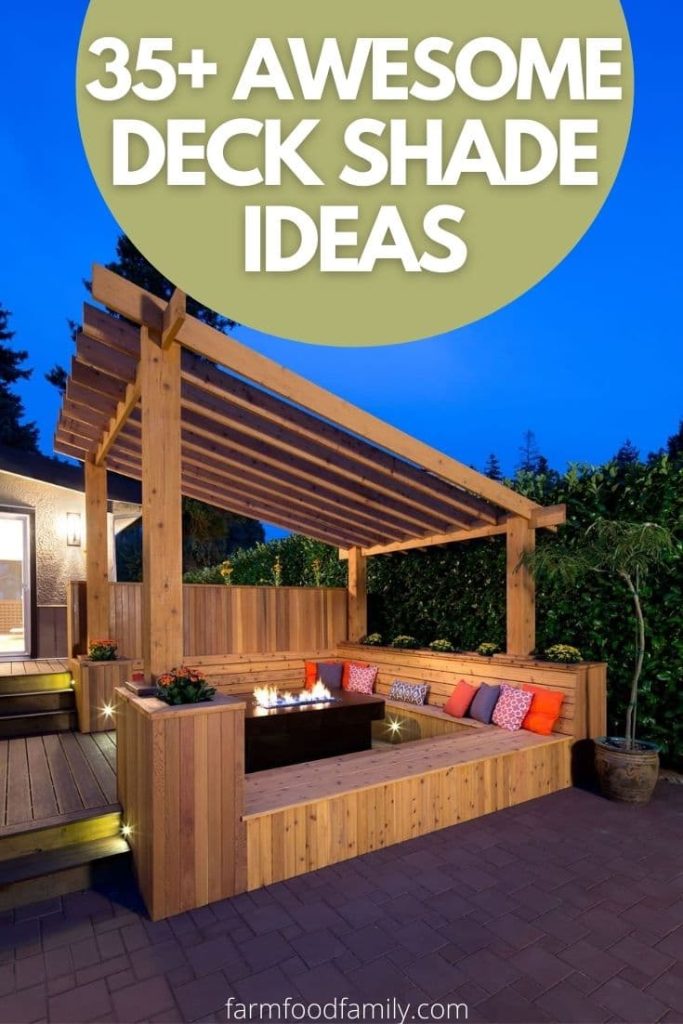
1. Pergola
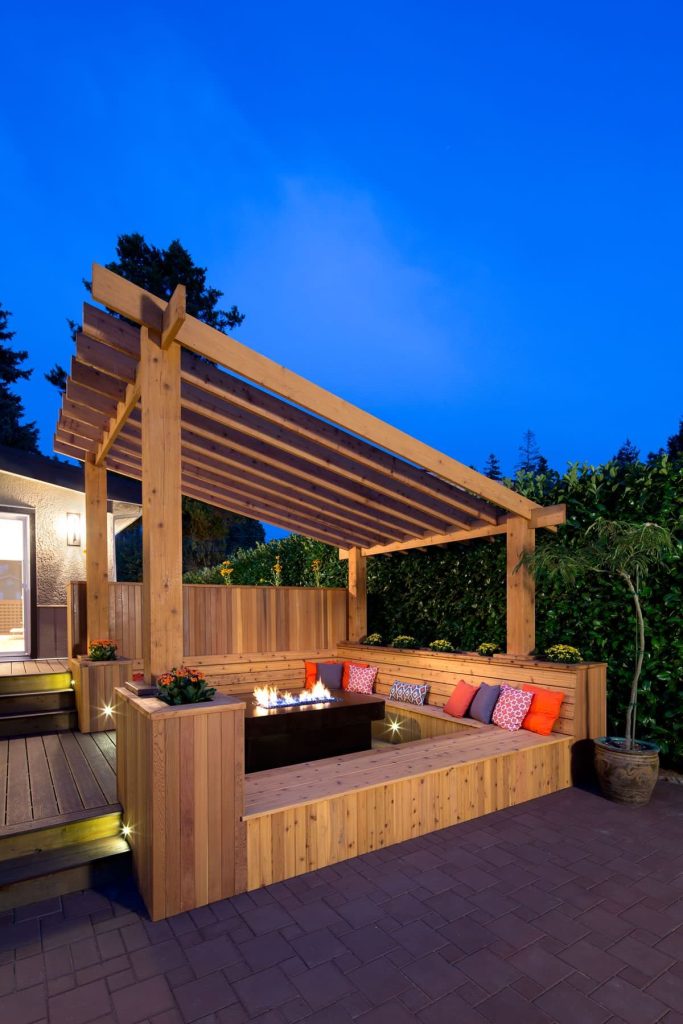

For a variety of reasons, a wooden pergola is an excellent structure to have in your garden. These are available in a variety of designs, ranging from simple and affordable to more intricate and expensive, or you can make one yourself out of timber if you’re handy with a saw.
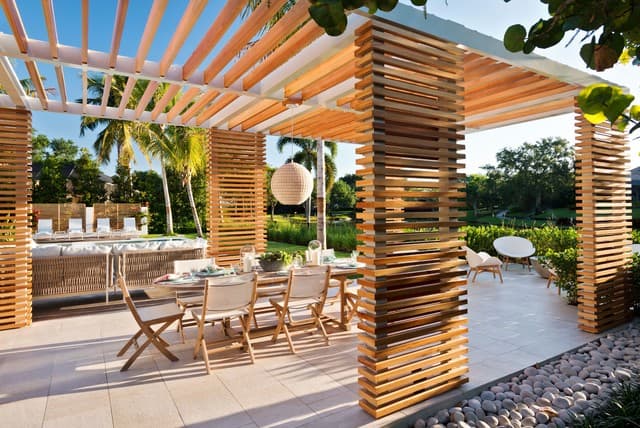
These structures are simple to build and can be put up in a day with two pairs of hands, whether you buy a pre-made pergola or design and build one yourself.
Because pergolas have generally open tops that allow the light to shine through, they will only provide tiny strips of shade; however, if you have your pergola put up over your patio or deck area, there are a few items you can do to produce additional shade.
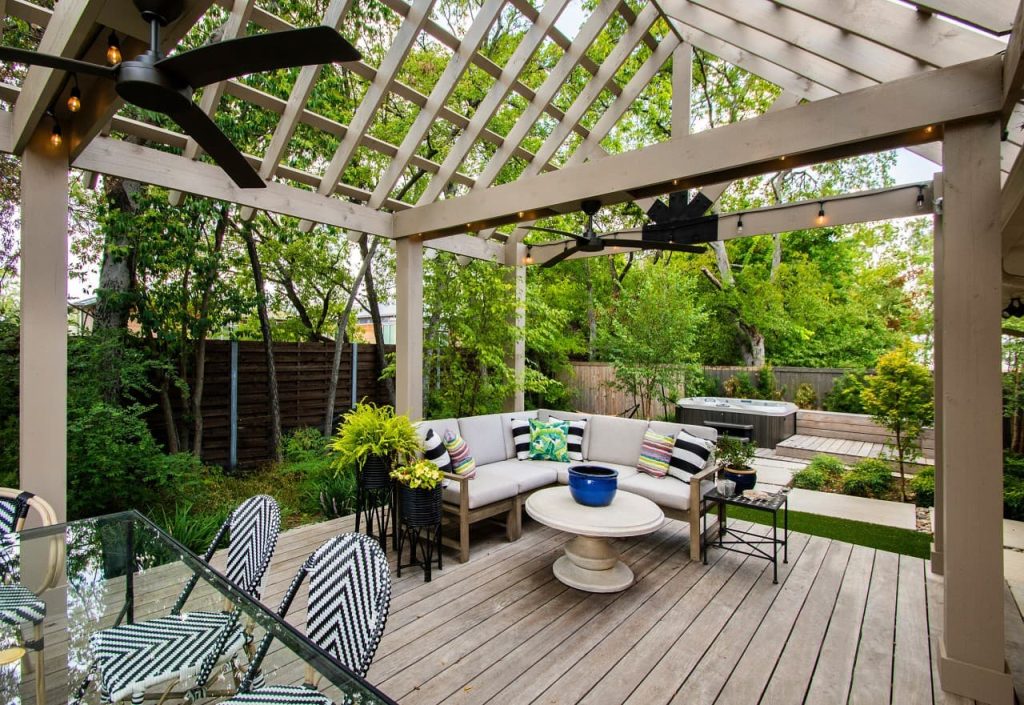
2. Vines
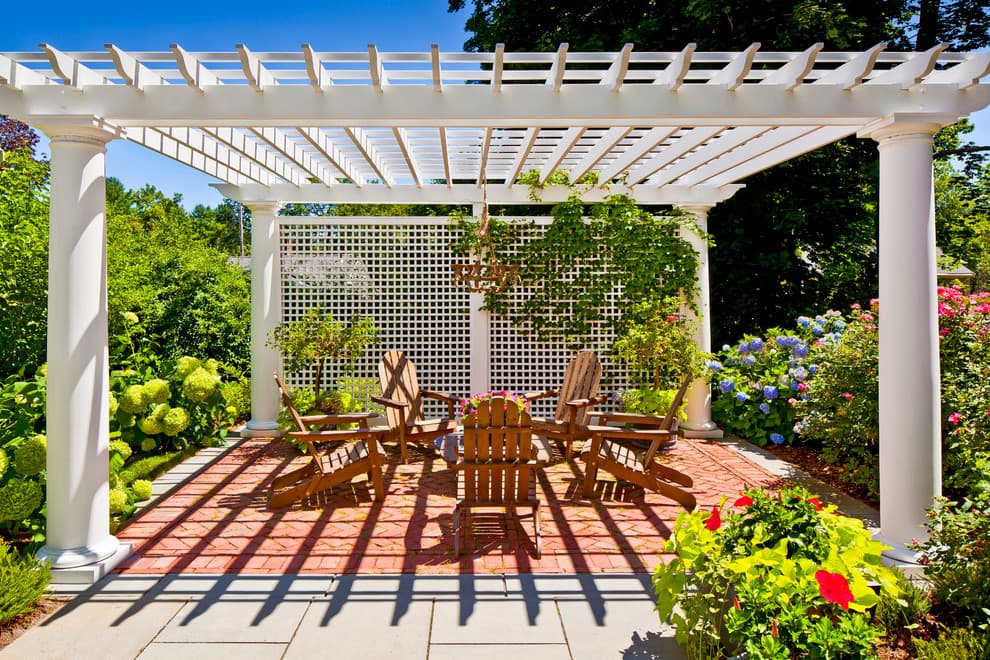
You may produce a deeper shade and a more appealing and bright feature by planting a climbing vine in a pot at the foot of each pergola post and allowing the plant to climb up and trail itself around the wooden posts.
The quantity of shade you obtain will be determined by the sort of plant you choose; for example, vines with broader habits and huge leaves will provide more shade, whilst slender plants would only provide limited shade.
Climbing vines are a decent alternative for dappled or intermittent shade, but they won’t create a completely covered area, so they’re not perfect if you need more consistent or stronger shade.
3. Baskets to Hang
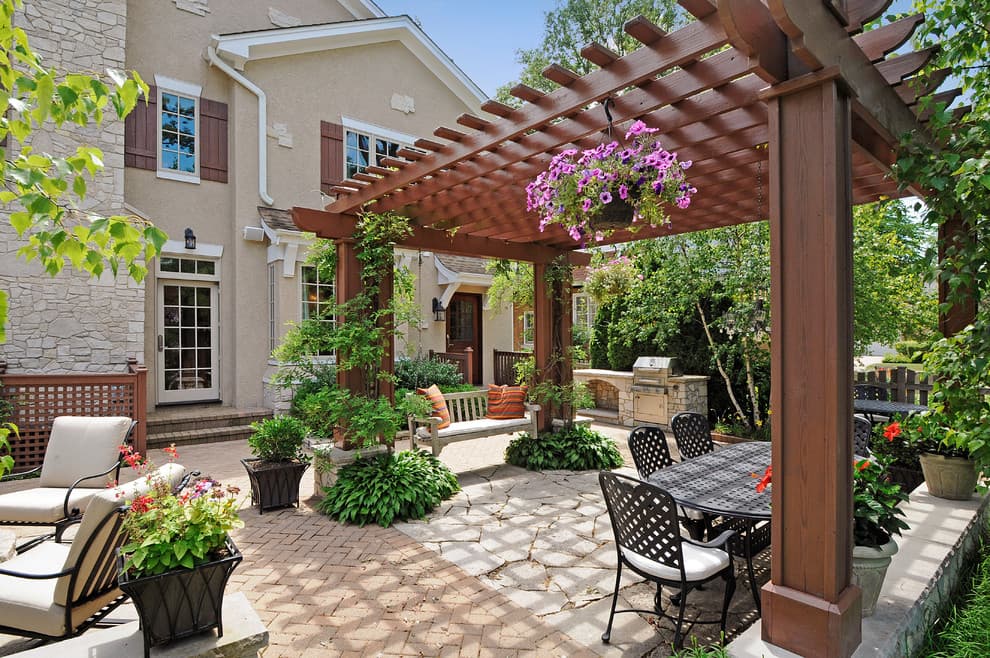
Pergolas are ideal for displaying a variety of hanging baskets across the upper perimeter of the structure, or even around the center beams.
Large hanging baskets with trailing plants will give more shade, while smaller baskets with more delicate plants may provide partial shade.
Hanging baskets with flowering plants will assist to improve the pergola’s shadow while also providing a colorful focal point.
4. Curtains
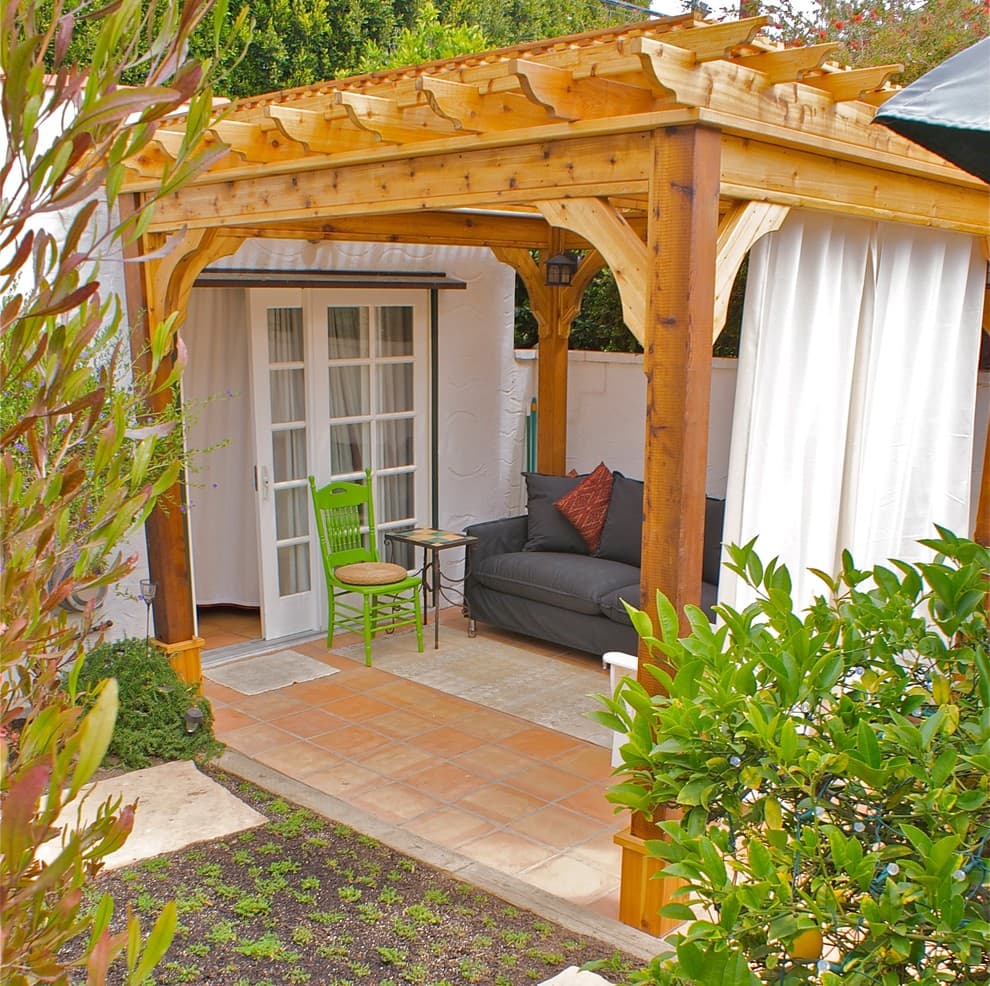
Curtains can be attached to a pergola in the same manner as they are to a wall indoors. This is an excellent non-permanent shade option since you can open the curtains when you want to let the light in and close them when you need to escape the heat.
When selecting a fabric, your options are not limited so you can be creative. If you want to let the light in, you may opt for thinner curtains.
On the other hand, if you want to keep your deck cooler, choosing heavy canvas or drapes is the best option. Fabric design also adds a sense of warmth to outdoor settings, making your place feel more opulent and comfy.
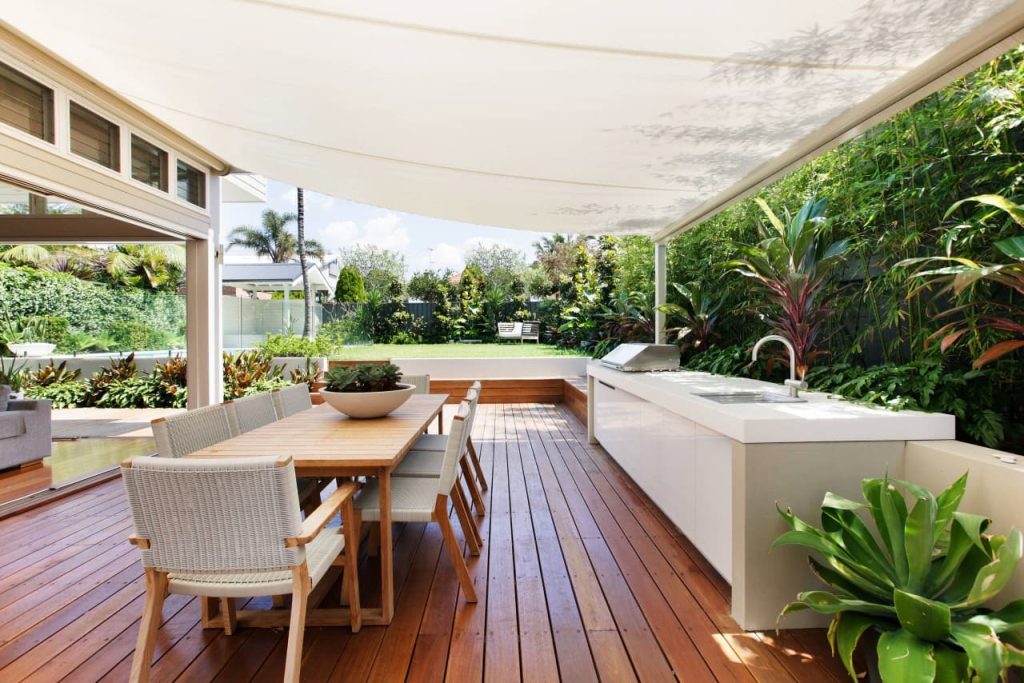
Awnings are perfect if you want to create a space that is covered, especially if your deck is located near the wall of your property.
Many awnings are retractable, allowing you to roll them in when they are not in use. Some folks think they are a touch dated, but if you’re ready to invest a little more money, you can obtain modern counterparts.
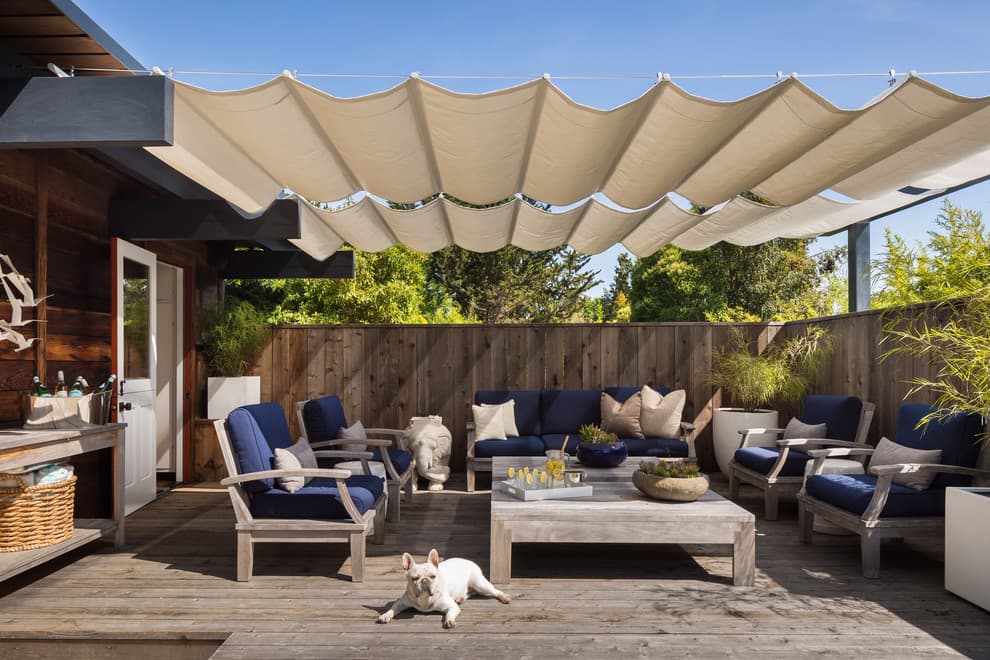
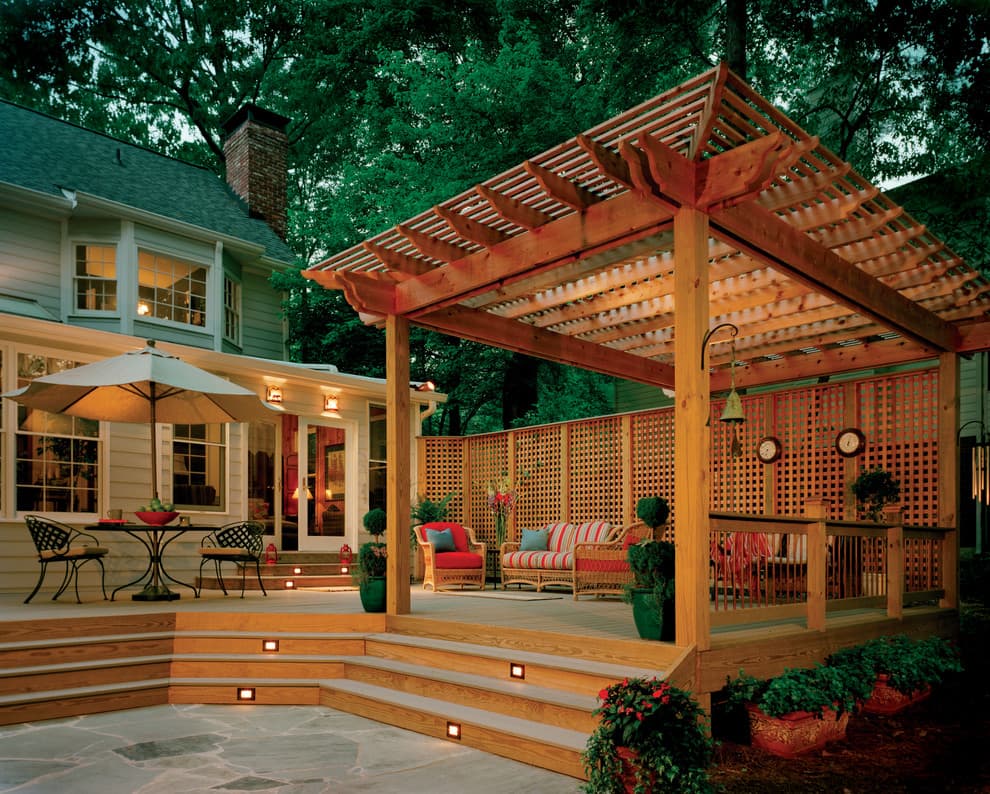
By placing trellis or an arbor strategically around your deck, you can definitely make an area that’s shaded. The structure, like a pergola, will not provide much shade on its own, but once covered with a climbing vine, this will substantially increase.
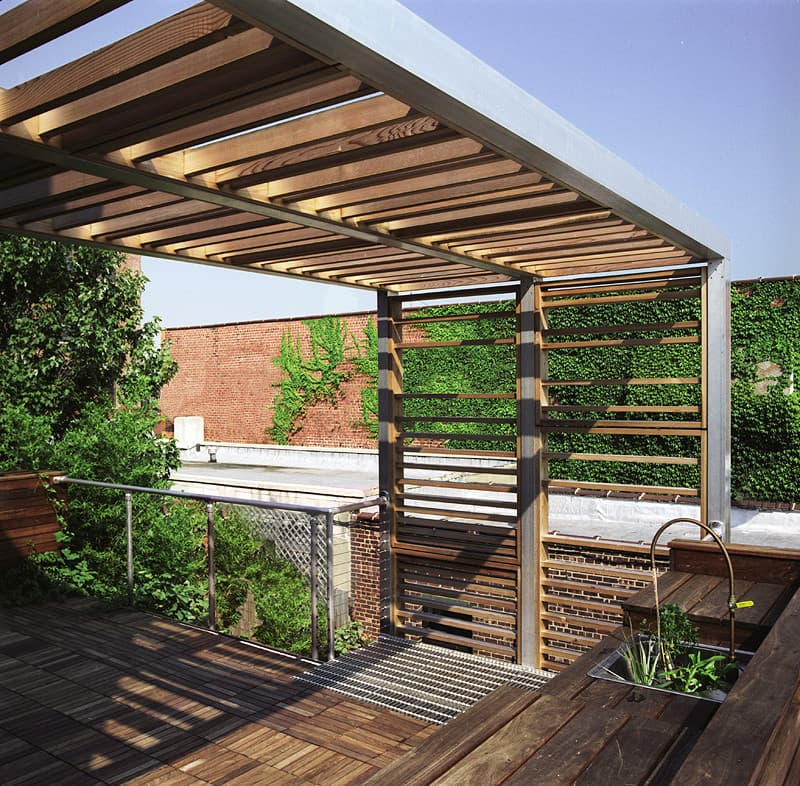
Plant a fast-growing vine like sweet pea or black-eyed Susan in early spring for semi-instant shade, and it should have stretched all over your trellis by summer, providing an appealing and vivid source of shade.
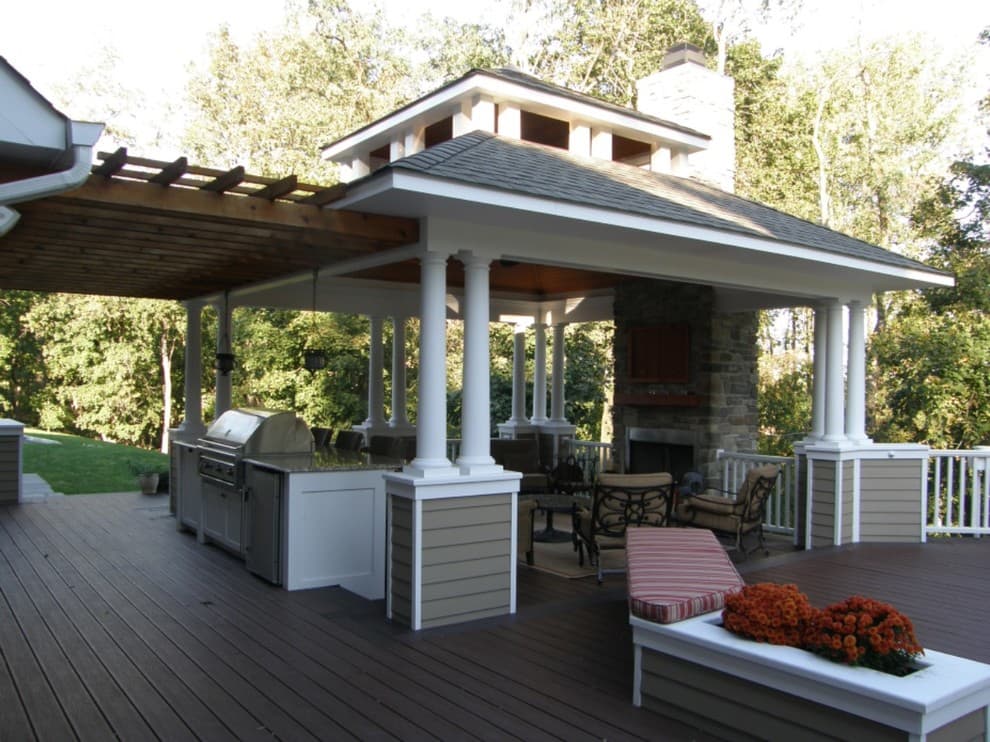
When it comes to constructing a covered space in your backyard, a pavilion is one of the more expensive alternatives, but it’s an investment that might pay off in the long term by increasing the value of your home and making it more appealing to buyers when the time comes to sell. A timber frame with a pitched, tiled roof is typical of this building.
Though a pavilion may appear to be more expensive than other garden shading options, it is really less expensive than adding on an extension to your home, and the end effect is quite similar in that you gain more usable square footage on your property.
8. Gazebo
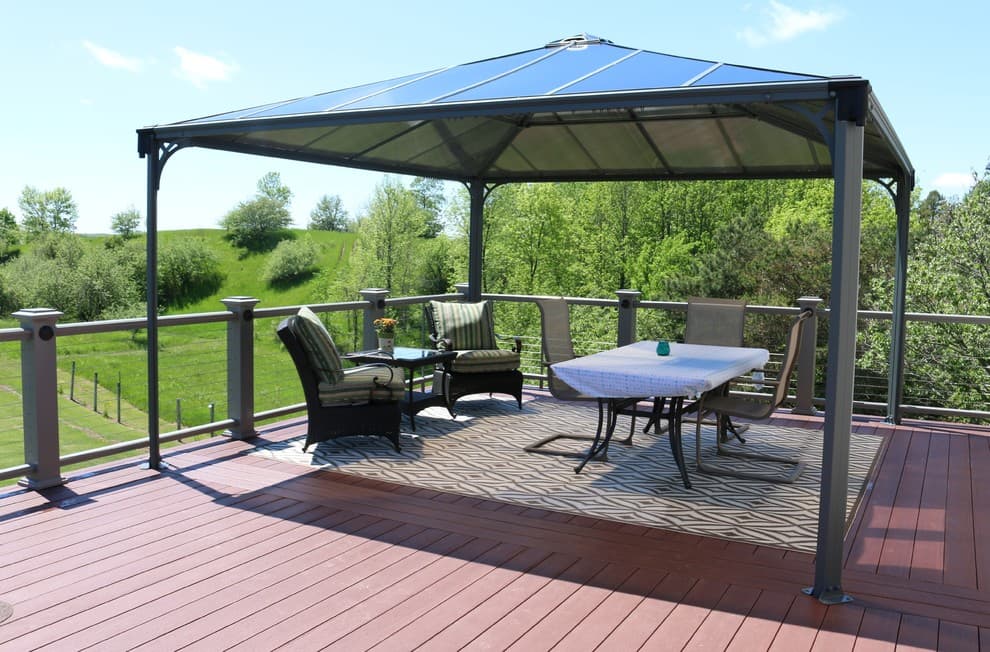
A pop-up gazebo is an excellent option for a totally shaded deck in a hurry. Compared to other garden shade structures, they may be acquired for a relatively inexpensive price, and they can be disassembled quickly and simply when the summer is through.
Semi-permanent gazebos, which may be built fast and bolted into the ground, and then removed at a later date, are a more durable alternative.
9. Trees in Containers

Citrus trees, for example, grow well in pots and may provide well-shaded regions when placed in the proper location. The advantage of utilizing container trees as shade is that they are moveable, allowing you to move them with the sun to get the most out of the shadow.
If you wish to create a bigger shady area, trees planted in pots may also be lined together to construct an excellent tree barrier.
10. Trees that have been planted
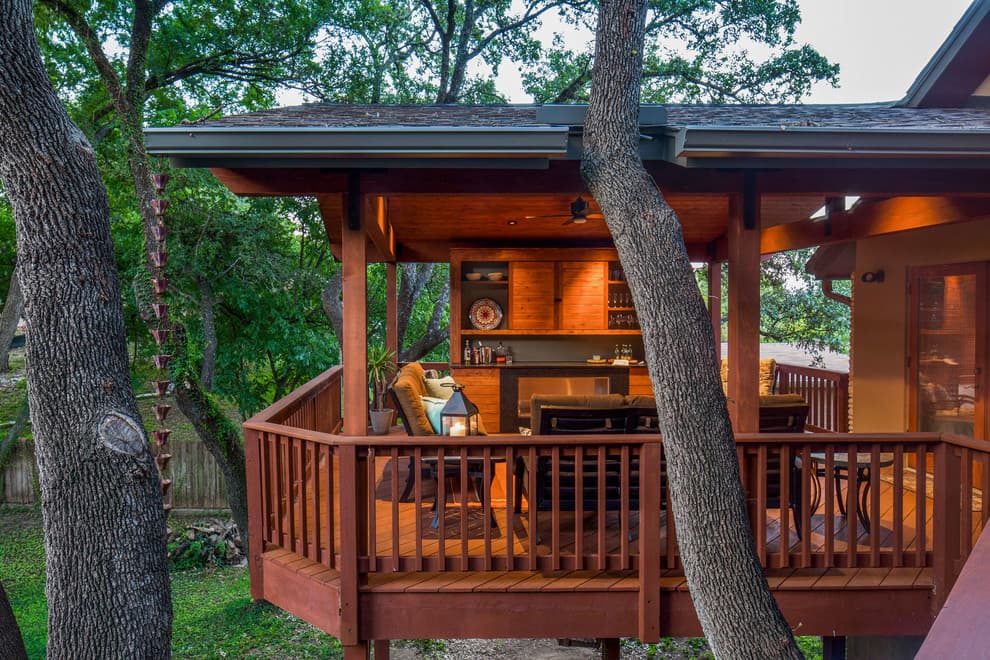
Shade may be created in your landscape by planting trees. Specimens with dense growth patterns give more solid shadow, and those with more spaced-out branches create more dappled shade.
Planting a tree, like growing a hedge for shade, does not provide instant shade, but it can be immensely enjoyable to see a tree develop from a little specimen. Alternatively, if you already have a mature tree in your yard, you might want to consider building a deck behind it to make the most of the shade you currently have.
11. Hedge

Growing a shade hedge may not be the immediate solution that some people seek, but it is a fantastic way to provide shade and seclusion around a deck or patio.
If you start the hedge from seed or young plants, it may be quite affordable to cultivate, as long as you are willing to wait a few years before it can be utilized as a source of shade.
Selecting a fast-growing shrub can allow you to reap the benefits of a tall hedge sooner, but this is not a quick fix.
12. Cabana
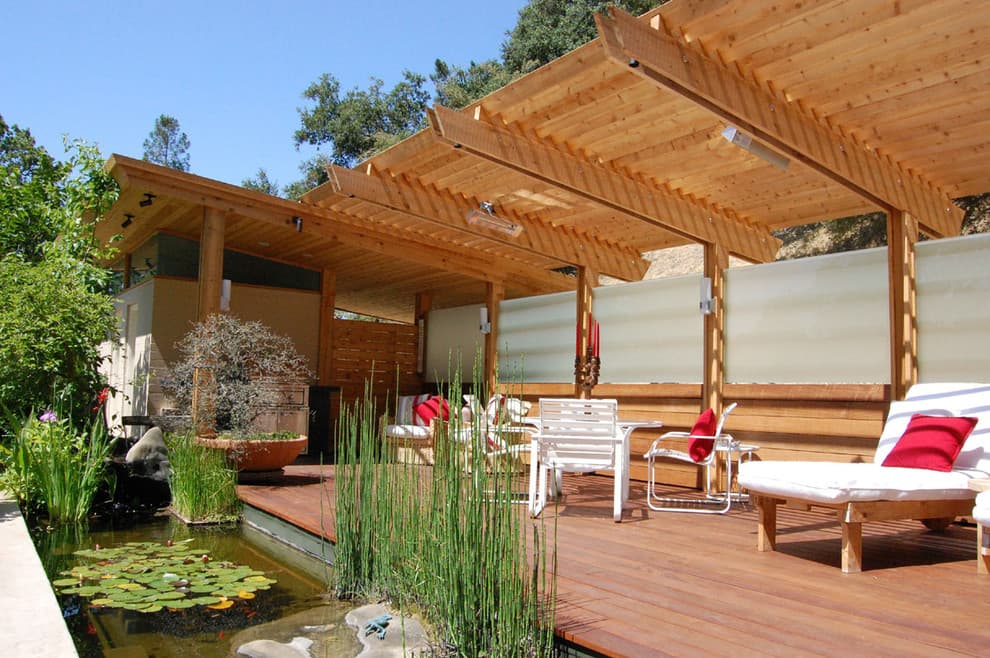
Create a cabana in your garden for the perfect holiday. These can be built from a metal or wooden frame, in a basic or sophisticated form, and can vary in design depending on your budget. Fabric sides of your cabana might either pull back or be fixed in place.
It might have a solid wooden or fabric roof, an open or curtained front, and a solid wooden or fabric roof. The cabana might be a permanent structure attached into the base of your deck, or it could be a metal frame that can be disassembled and stored until next summer.
13. Sail on Canvas
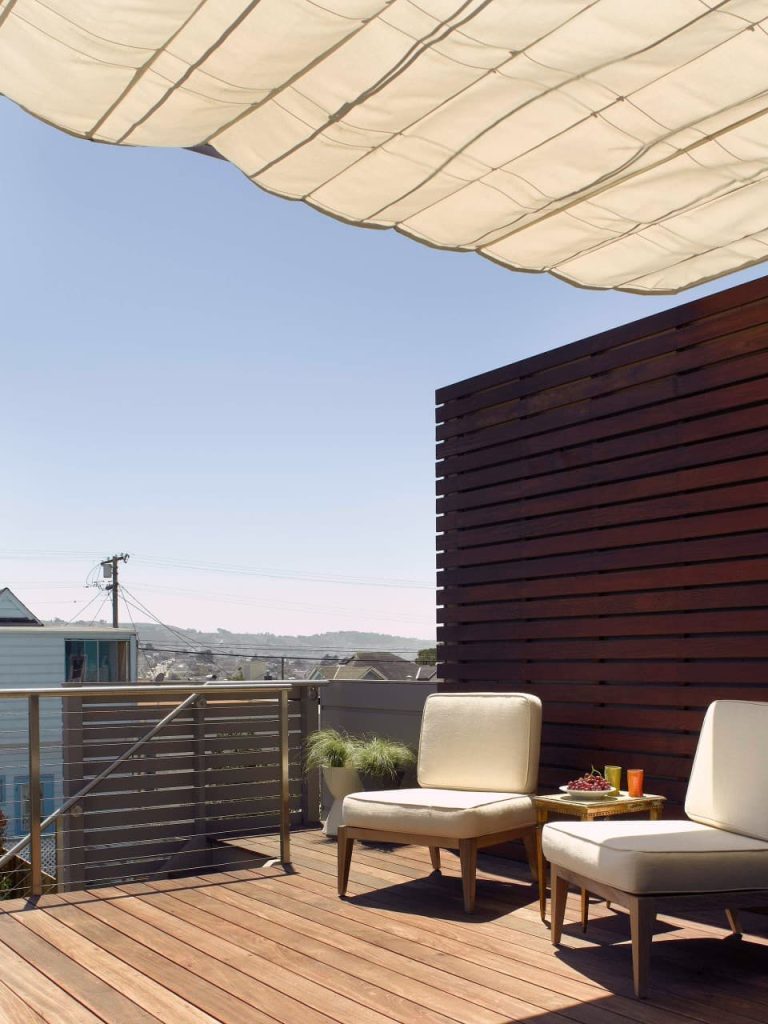
A canvas sail is a cost-effective and easy technique to provide shade. You may buy a purpose-built shade sail or construct a DIY shade sail out of an old boat sail to make this work.
With the help of metal hooks and twine, these triangular pieces of canvas are attached to the rear wall of your home.
Screw the hooks into a stable structure, such as a wall or fence, and set it at an angle that will give the optimum shade at the time you need it. Shade sails, which come in a variety of sizes, may give substantial shade that can be customized to the size you want.
14. Parasol / Sun Umbrella
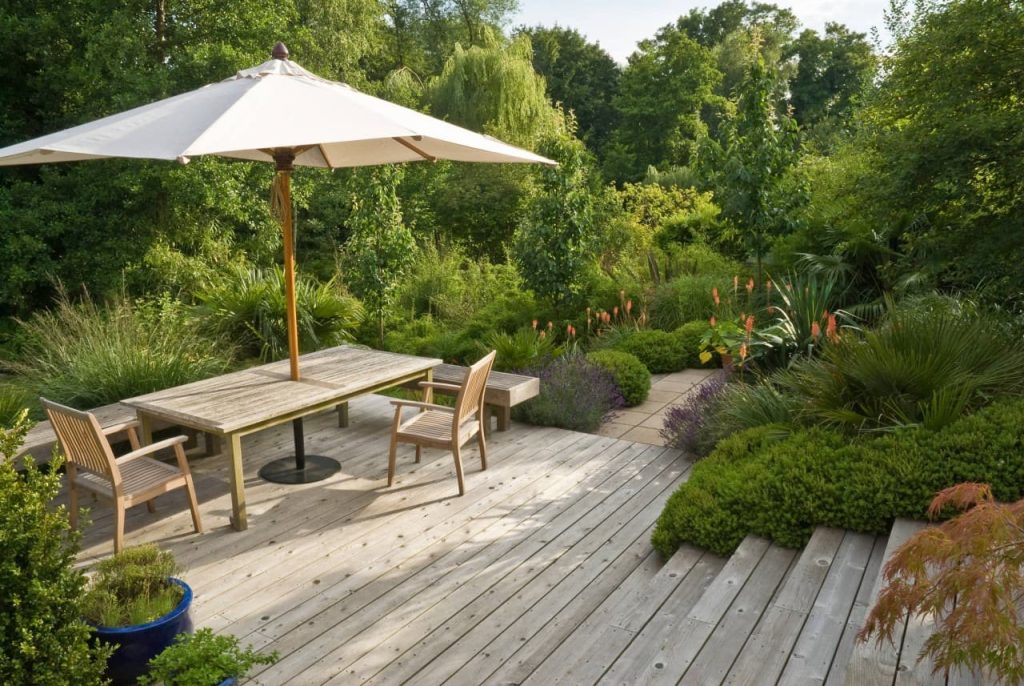
A parasol or sun umbrella is the most frequent way to provide temporary shade to a patio or deck area, and it’s easy to understand why: they come in practically any price range to fit the user’s budget, are simple and quick to raise, and can be readily stowed when not in use.
An outdoor dining table or picnic bench with a hole through the middle where you can slot the umbrella is required to make the most of a sun umbrella. Use a weighted parasol base to keep it secure, stable, and from blowing away in heavy winds.
15. Ceiling made of bamboo
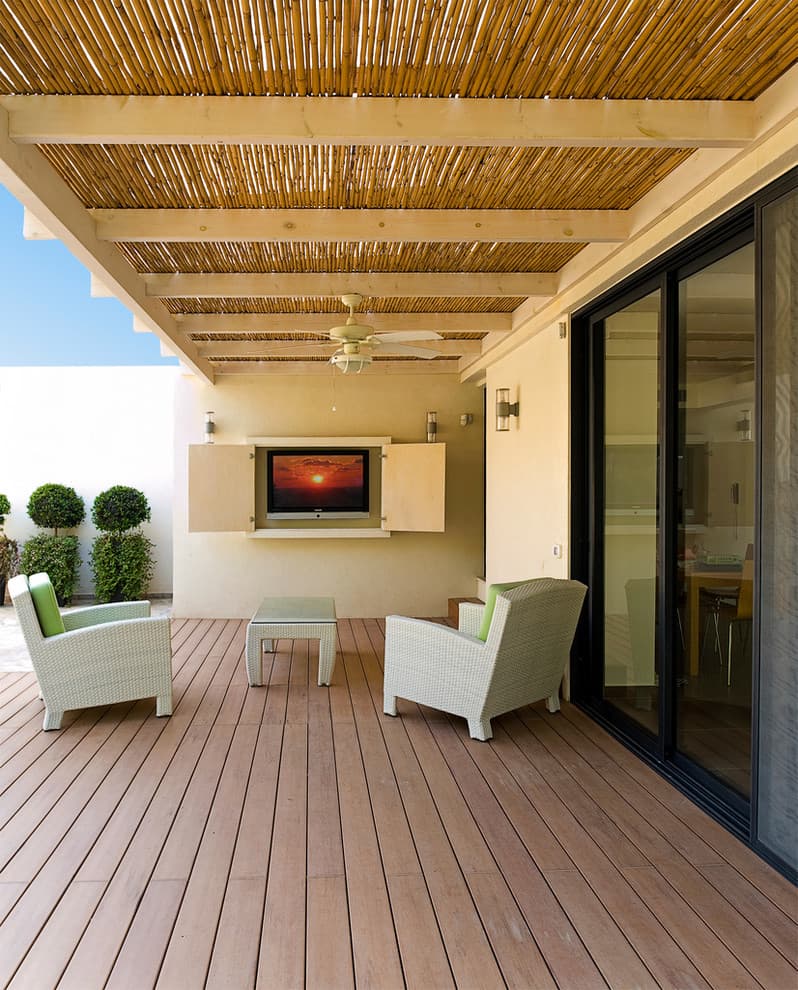
Purchase bamboo sheets and staple or tack them to the pergola’s top ceiling boards for a rustic look. Depending on how densely packed the sheets are, this will create an almost solid shadow with minor slithers of light shining through.
16. Ceiling made of fabric
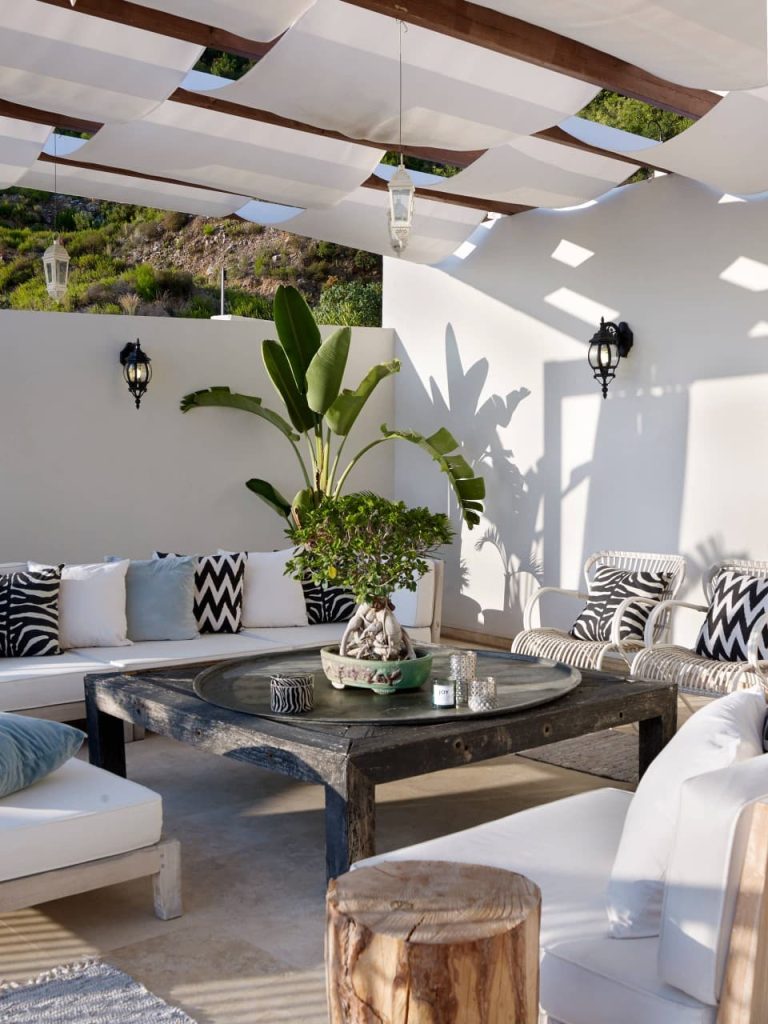
Adding a cloth ceiling to your pergola is a cost-effective and simple solution to provide optimal shade for your patio. Use fabric lengths to drape under and over each pergola ceiling board, then secure them at the ends.
This will give your yard an exotic holiday feel while also providing adequate shade. You may adjust the amount of shade to suit your family’s needs; for dappled shade, drape the cloth through loosely and casually, while for solid shade, make sure the fabric is coiled through tightly to avoid gaps.
17. Shade sails should be hung

Shade sails are another low-cost outdoor shade solution that may be used to shade small areas or give entire patio coverage.
This one is especially good if you’re looking for something that will provide filtered sun in areas where rain protection isn’t a concern.
18. Build a Palapa
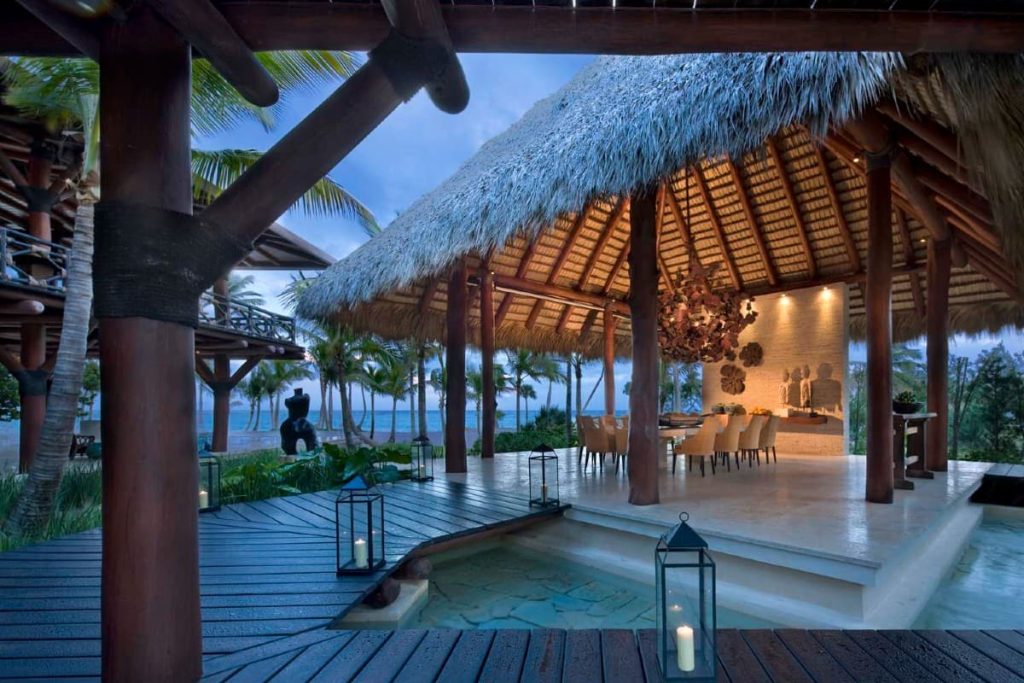
Palapas, which are often built of bamboo and have a thatched roof, give lots of shade and a tropical atmosphere.
A palapa can be the appropriate shade structure for you if your backyard goals involve creating a tropical paradise for your friends and family to enjoy.
19. Plant trees at strategic locations
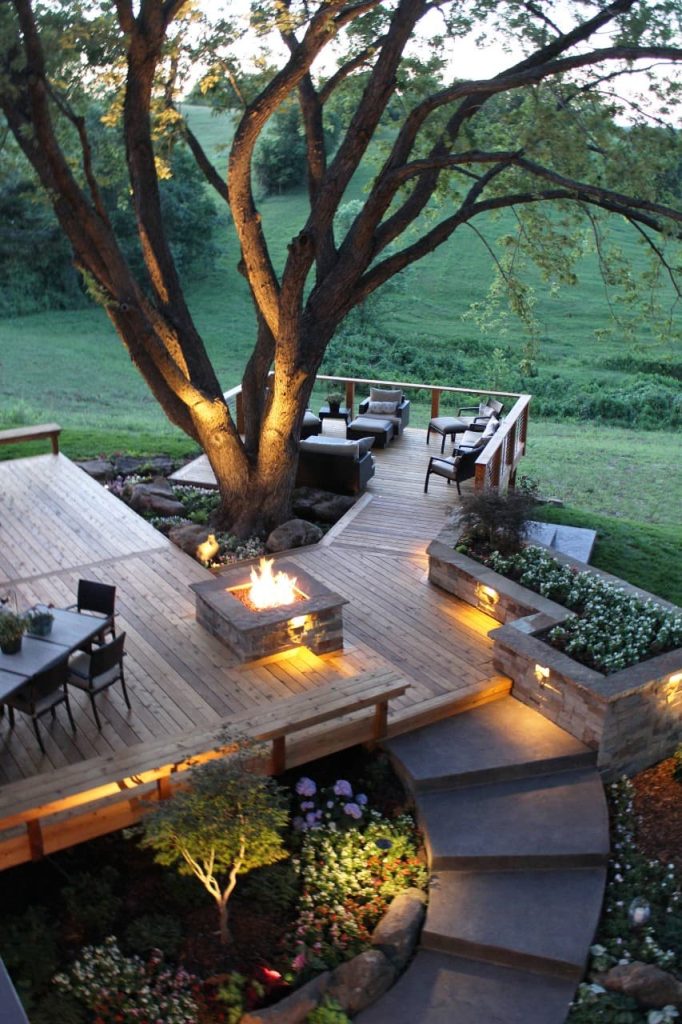
Trees strategically placed in outdoor living areas are an excellent alternative for giving natural shade. Choose evergreens if you wish to have shade all year.
20. Invest in a pop-up canopy
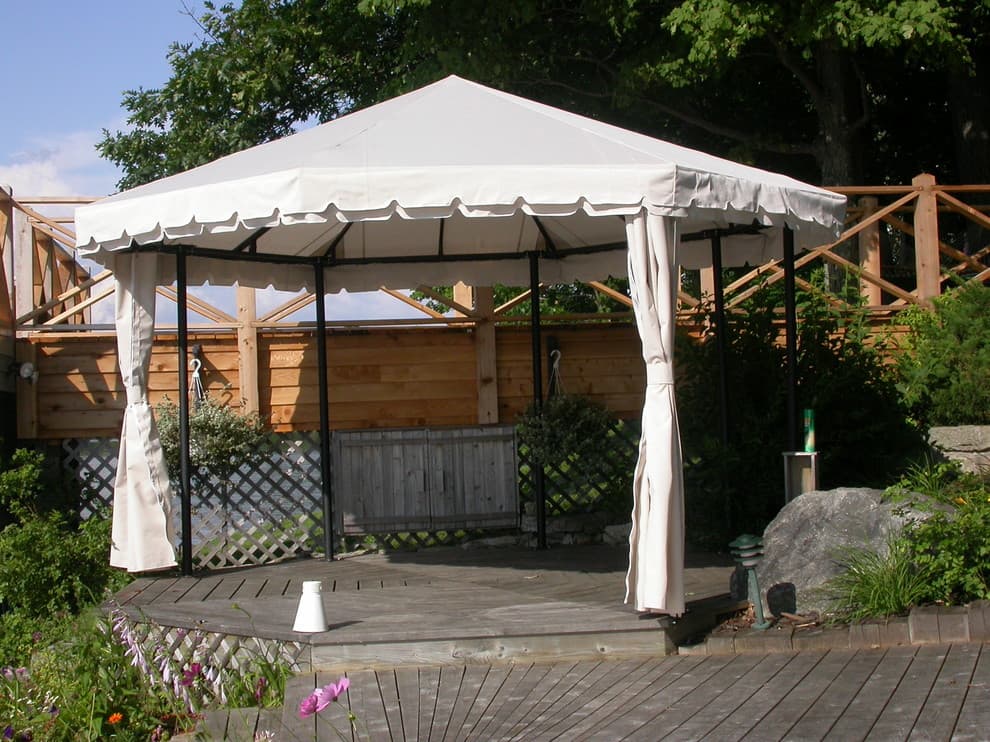
Pop-up canopies aren’t the most beautiful of outdoor shade options, but they’re practical, affordable, and ideal for situations when you need temporary or mobile cover.
Pop-up canopies are useful for giving temporary shade over play areas or for providing additional cover for parties that are too big to fit on your patio.
21. Construct a long-term roof structure
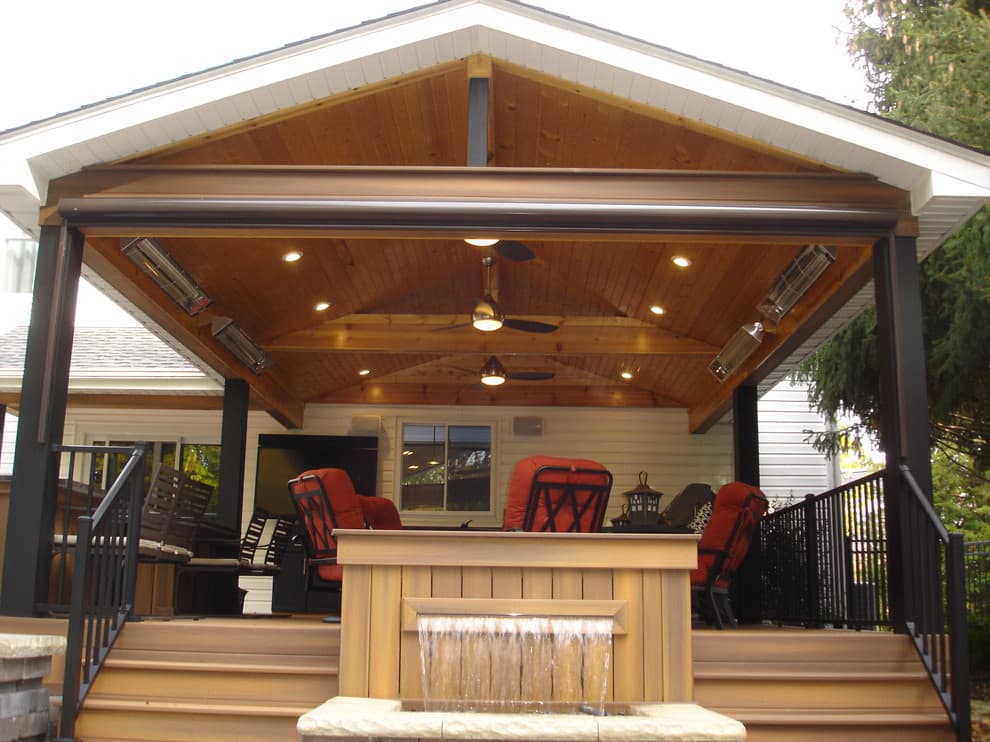
A permanent, solid roof is one of the more expensive patio shade solutions on this list, but it is significantly more durable and long-lasting than a palapa, canopy, or patio umbrella if you have the means.
If you have a two-story house, you may be able to cover your patio and increase your outdoor living areas by adding a second-floor roof structure that also serves as a balcony.
22. Make use of hoop shades
If you’ve ever seen a hoop shade, it was most likely sheltering crops in a field. Hoops shades are a shade structure that looks like a mix between a canopy and a tent, and they work well for both plants and parties.
They’re simple to make from PVC tubing and shade cloth, and they can be built right before a party or weighted or staked to stay put for the long haul.
23. Roller blinds should be hung
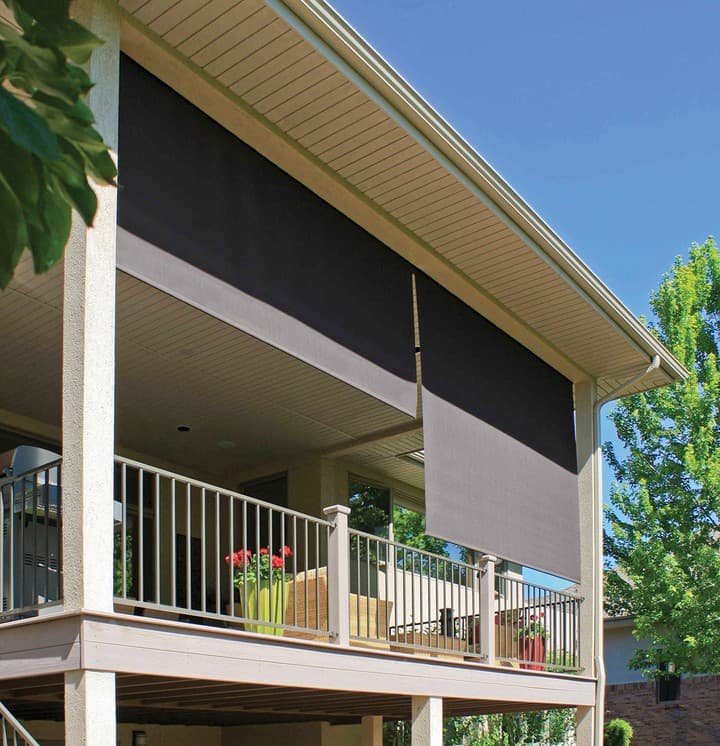
Outdoor rolling shades may be installed practically everywhere that curtains can be installed and provide the same benefits of privacy, shade, and weather protection.
Hanging rolling shades is a very straightforward do-it-yourself job, making this a simple patio cover concept to implement in your backyard.
24. A retractable awning should be installed
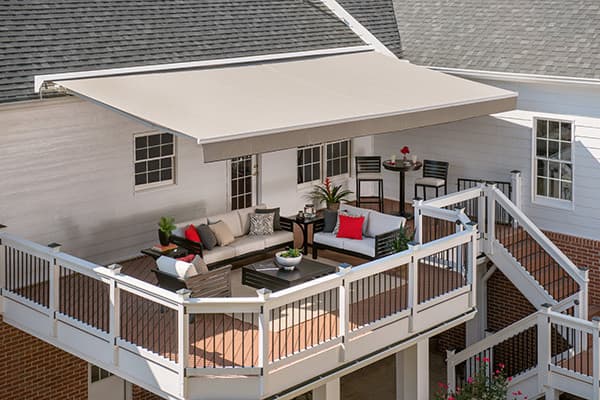
Retractable awnings, like fixed awnings, provide sun and rain protection. Some individuals, on the other hand, like this choice since it allows them to retract the awning and reveal their outdoor living areas.
This means you may have an afternoon tea party beneath your canopy, then retract it before your outdoor evening party so your guests can dine under the stars.
25. Place a cinema screen at a strategic location
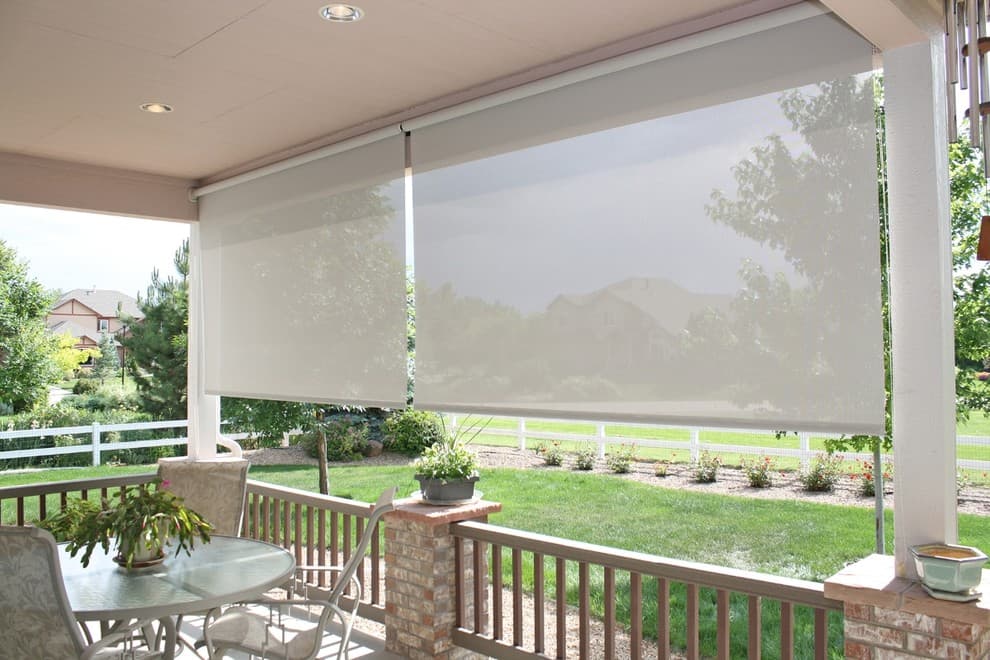
One element that springs to mind when it comes to patio shade ideas is a properly positioned movie screen.
When properly installed, your outdoor screen may provide shade during the day and serve as the ideal location for an evening movie under the stars.
26. Build a yurt
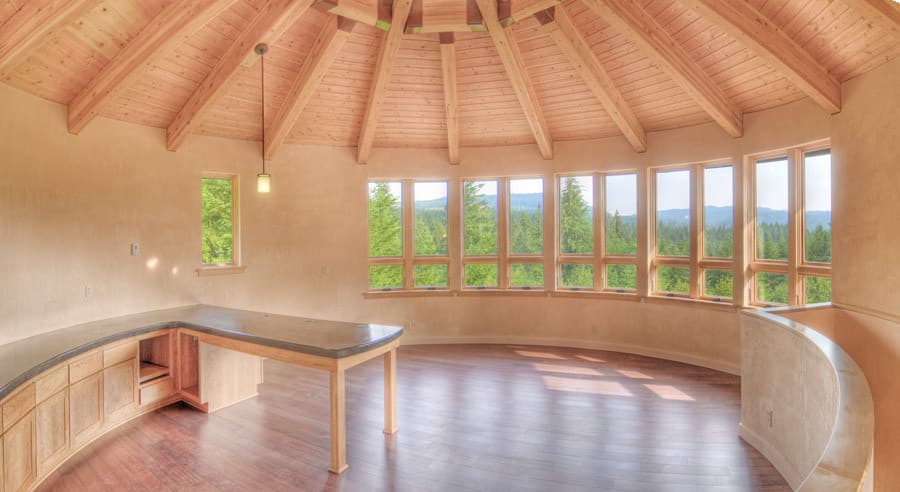
A yurt is a spherical, tent-like building used by nomadic Mongolians for shelter. Yurts have grown in popularity in North America as an alternative dwelling choice and for use in backyards as guest quarters, meditation rooms, playrooms, or even backyard offices during the last several years.
27. Roman shades
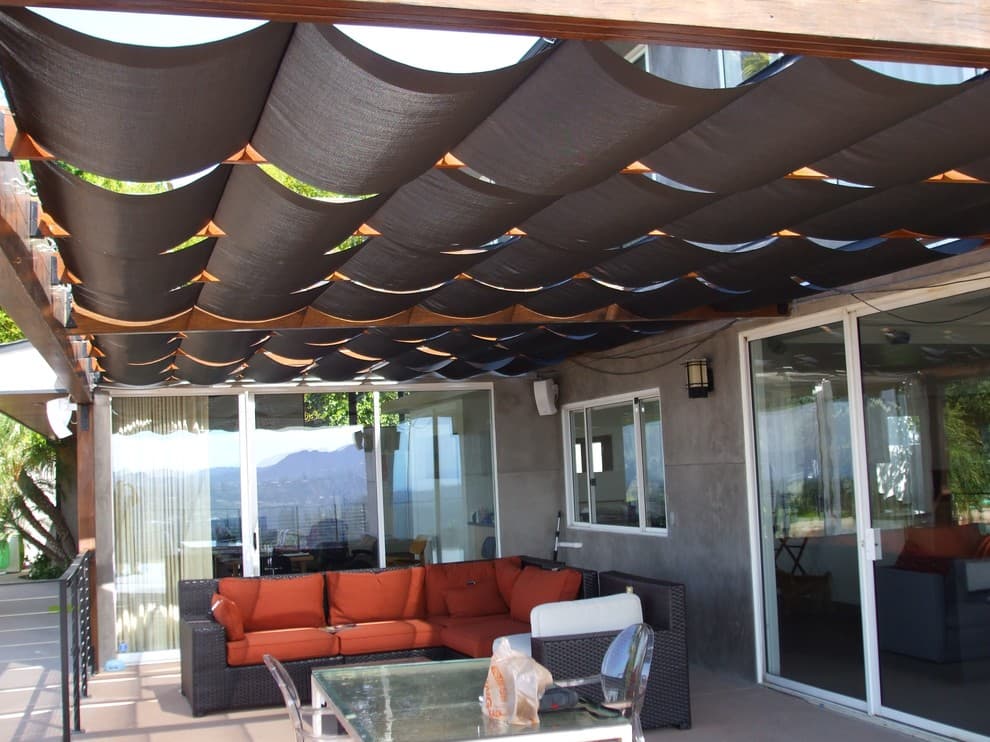
Fabric can be connected to a sliding wire to make outdoor Roman shades to cover the top or sides of a pergola or other shade structure, similar to how Roman shades are used indoors.
One of the advantages of Roman shades is that depending on how much you open them, you may cover your patio totally, partially, or not at all.
28. Using moveable panels is a good idea
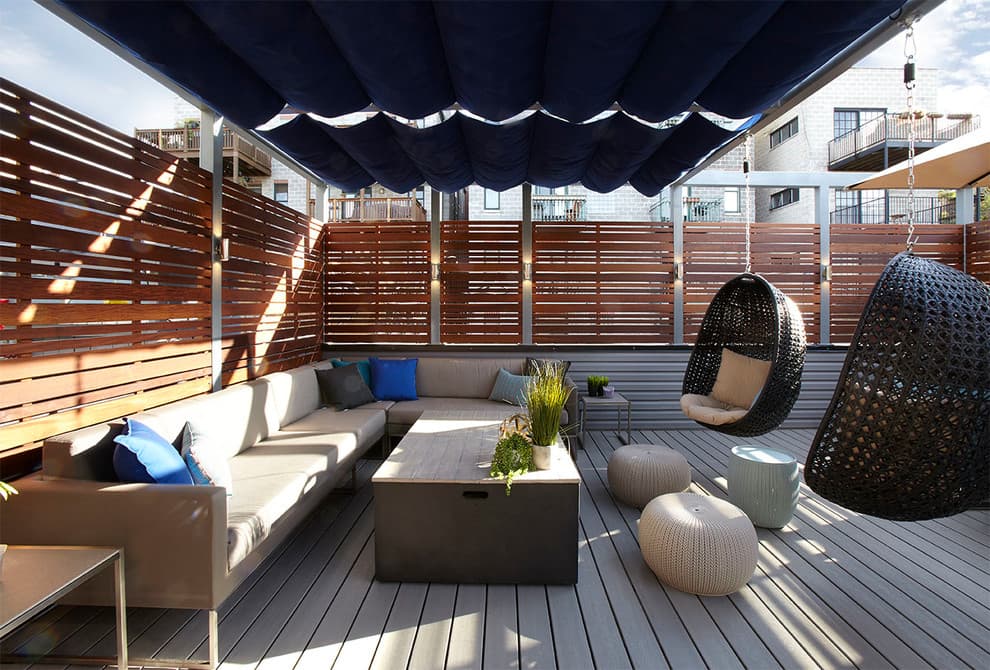
Metal or fabric movable panels may be changed to give shade at different times of the day, provide seclusion around your patio, divide different areas of your outdoor living rooms to create a more private feel, or open up the space to accommodate bigger groups.
29. Patio umbrella with an offset cantilever

With an offset cantilever patio umbrella that rotates 360 degrees to block out the sun where you need it most, you can take your outdoor shade ideas to the next level.
The offset design provides for extra sitting as well as a cooler environment beneath.
30. Tiki Umbrella
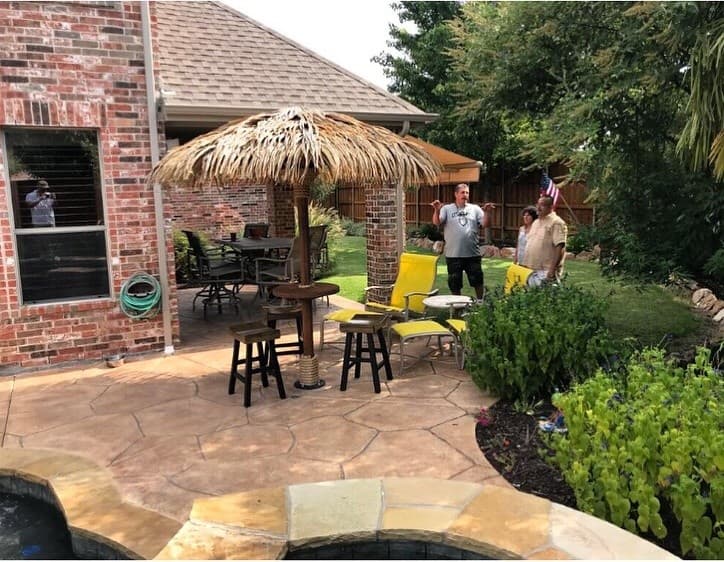
With a tropical tiki umbrella, you can create your own backyard paradise at your bar, poolside, or anyplace else you need patio cover. Friends and family will enjoy lounging under your thatched umbrella.
31. Pergola with Lattice
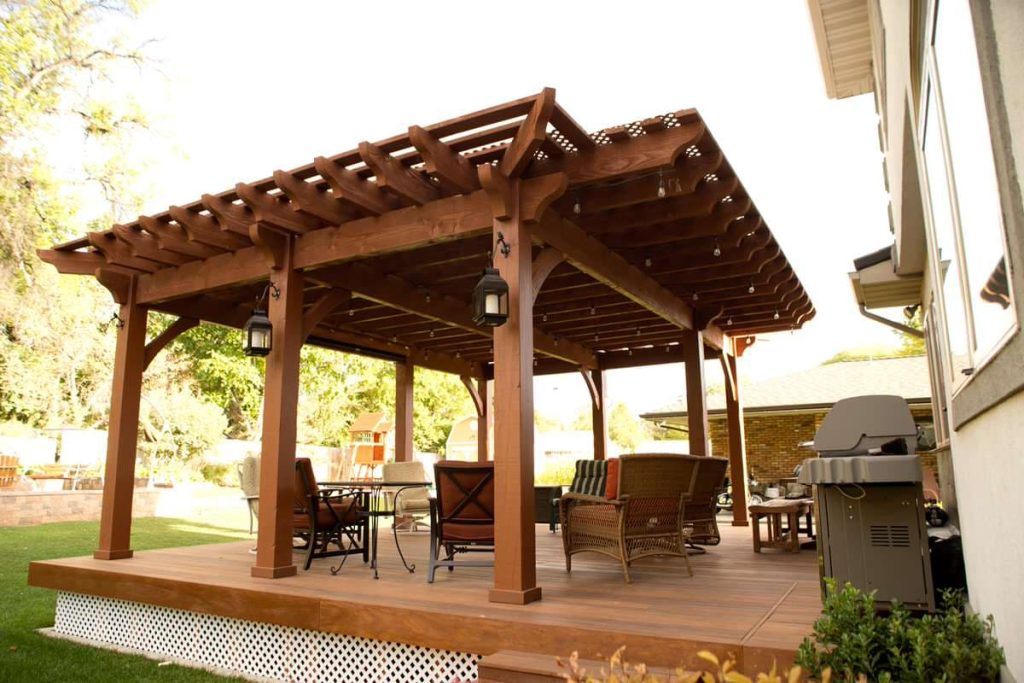
Shade and a location to build a beautiful garden canopy are provided by pergolas with a lattice ceiling. Consider if you’ll maintain it “as is” or add some more shade with wisteria or climbing roses, since the lattice slats come in a number of thicknesses.
32. PVC sun screen canopy made at home
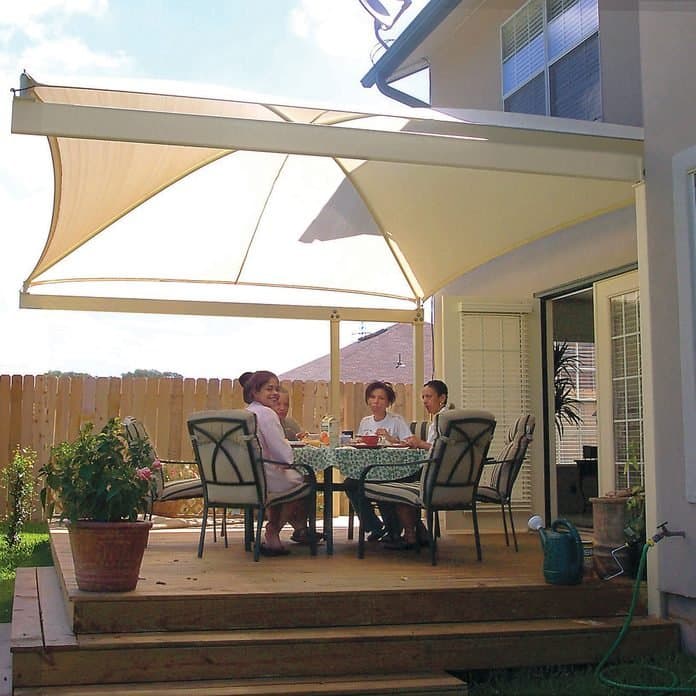
Make your own sun cover canopy out of PVC pipe to suit your individual needs. Because PVC pipe is so versatile, you can quickly change the length and breadth of your shaded area.
33. Canopy in a bohemian backyard
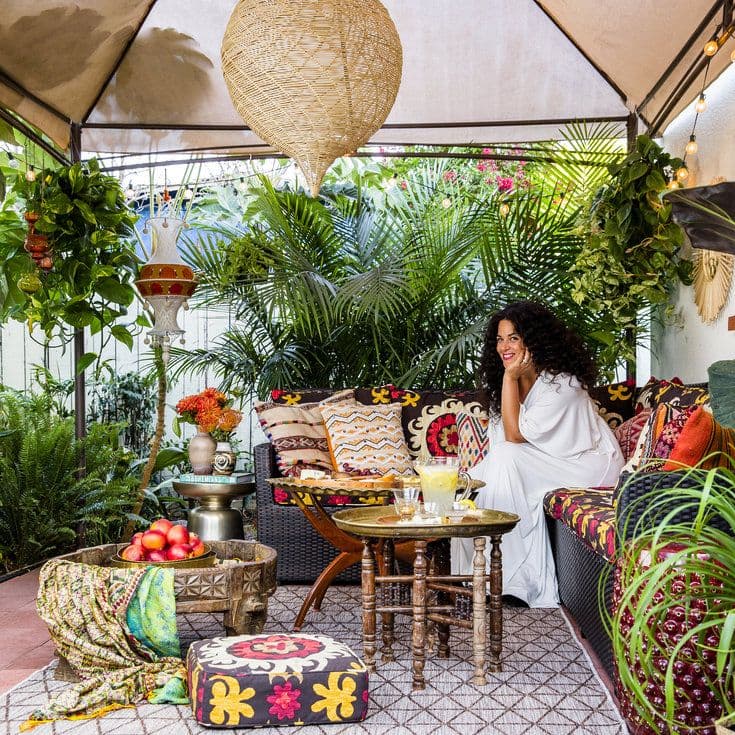
Are you looking for bohemian-inspired garden shade ideas? An airy cotton fabric garden canopy will provide a relaxing or meditative environment.
34. Make a Shade Sail

One of the simplest sun-blockers you can create is a sail shade. A triangular-cut piece of cloth with eyelets punched in the corners is all that’s required. Attach the shade to poles, the side of the house, or surrounding trees with sturdy twine or rope.
35. Consider Loggia

If you’re looking for something a little more upmarket, go no further. Loggias are covered areas that run the length of a structure and are generally adorned with columns and arches of some form.
While it takes a little more time and work, the end product may offer a touch of elegance and luxury to your outdoor space while also keeping things cool and pleasant.
FAQs
What can I use for deck shade?
There are several backyard shade alternatives available to keep you cool. Your budget and the size of the area to be shaded are also important factors to consider. A shady paradise is achievable whether you buy a ready-made building or build your own bespoke design.
Take time to analyze the area at different times of the day before beginning your backyard shade project, since the sun’s position may fluctuate.
How do you cover the sides of a deck?
Awnings, roof extensions, arbors, pergolas, and other overhead coverings are only some of the alternatives for deck covers. The best deck covering is one that compliments your home’s beauty while also improving its utility.
Although hardwood or composite decks seem beautiful, you may not be able to enjoy them if the weather is too hot or it is raining frequently. Make sure you cover your deck to get the most out of it. You can utilize your deck all year long with high-quality deck coverings, regardless of the season.
It’s important to seek advice from an expert on the best design, size, and kind of deck cover for your deck.
How do you secure a canopy to a deck?
Gazebos are incredibly adaptable outdoor structures, and in addition to being a fixture in the garden and on the lawn, both pop-up and permanent types may be placed on decking and even linked to your home.
Both temporary pop-up gazebos and permanent hardtop gazebos are suitable for use on your deck. Simply screwing down each leg, or weighing them down with linked metal straps, tiny concrete blocks, or sunk into huge, heavy plant pots, can hold them to the deck without destroying it.
More deck ideas:
Conclusion
There are several patio blinds available that will allow you to spend the entire day on your deck. It doesn’t matter if your patio is cramped or generously sized.
With simple and sophisticated embellishments to adorn it, you will not go out of style. Patio blinds are also often affordable and simple to install.
So, make the most of your deck by securing it against the weather with these fantastic patio shade options.
People go to the great outdoors for enjoyment and leisure no matter what the season is: from spring picnics to outdoor pools, school field excursions, outdoor concerts, play dates, and more! The peacefulness of nature might be challenged by unexpected weather if there isn’t a sheltered spot to escape the elements.
Choosing the correct shade structure for your outdoor space is critical for safety and comfort, and it’s a cost-effective investment that will pay for itself in terms of durability and energy savings.

